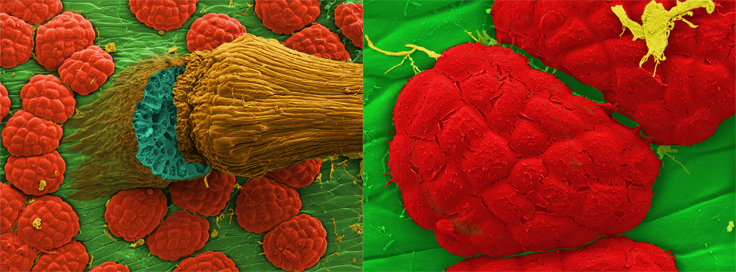Prey recognition
People involved


How does Dionaea recognize its prey?

Dionaea catches its prey with leaf extensions that have evolved into snap-traps: when an insect touches the hair-shaped mechano-sensory organs on the surface of the trap, electrical impulses are fired, triggering the trap to snap shut in a flash. Obviously, the trapped animal will try to escape, but the more ferociously it fights, the more it will touch the sensitive hairs. This triggers a train of electrical impulses and initiates the production of touch hormones of the jasmonic acid type. The hormone acid activates the numerous glands that are densely packed on the inside of the trap. They flood the "green stomach", formed by the closed and hermetically sealed capture organ, with an acidic fluid containing a cocktail rich in all kinds of lytic enzymes. This secretion process is highly dynamic, and apart from being triggered by mechanical stimulation and touch hormones, may be additionally tuned by the food quantity and quality. In this current project, we aim at elucidating the molecular mechanisms underlying the chemo-sensor(s) that allow the plant to recognize the nature and quality of the prey so as to adjust the secretion accordingly. To achieve this, we are combining molecular biology (transcriptomics), protein biochemistry (proteomics) and cell biology.
The major prey of the Venus flytrap are insects. Insects are shielded by a chitin coat that frequently comes with fungi often pathogenic to non-carnivorous plants. Consequently, the plant elicits defense reactions. Recognition of microbe associated molecular patterns (MAMPs) like chitin, which is not present in the host organism, is part of a plant’s innate immunity. The molecular nature of MAMPs can be as diverse as fungal chitin, bacterial lipopolysaccharides (LPS), peptidoglycans (PGN), quorum sensing factors or flagellin. Non-self-perception, which is related to innate immunity, represents a remarkable evolutionary conserved mechanism in both plants and animals. “Foreign” pattern-recognition receptors (PRRs) are employed for sensitive and rapid detection of any potential threat caused by microbial pests. Our profiling experiments reveal that the Dionaea transcriptome, like that of many other plants, encodes a considerable number of PRRs. Furthermore, it appears that stimulated Dionaea traps are characterized by upregulated pathways related to defense responses and stress adaptation. It is thus fascinating and pertinent to further elucidate whether and how Dionaea turned the sword, modifying ancient defense strategies to capture and consume herbivores.






